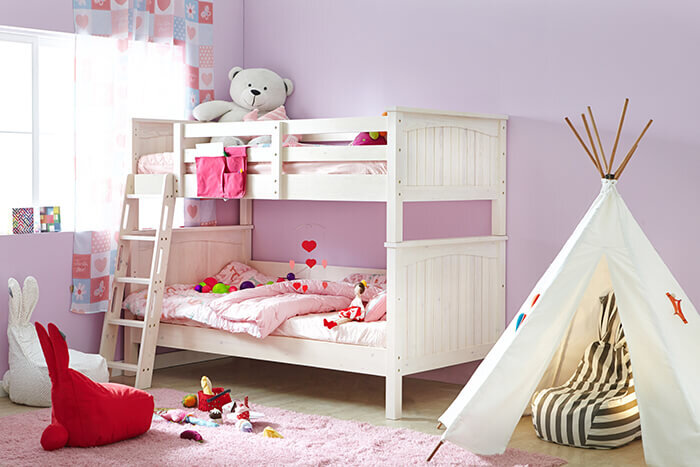Are Bunk Beds Right For Your Kids?
What Kid Doesn’t Love a Cool Bunk Bed?
Deciding whether a bunk bed is the right choice for your kids involves more than just saving space—it’s about safety, functionality, and meeting their unique needs. Bunk beds can be a fun and practical addition to a child’s room, but they’re not always the best fit for every family.
In this guide, we’ll walk you through the key factors to consider, including safety features, age-appropriateness, room layout, and lifestyle needs, to help you make an informed decision that works for your family.
Bunk beds, also known as loft beds, offer parents a smart way to save space in their kids’ bedrooms.
If you’re weighing your options and trying to decide which choice is right for you and your children, you may want to consider these tips so you know how to decide if a bunk bed is right for your kids.
Age & Maturity For Bunk Beds
Best Bunk Bed Buying Guide Tips
Loft beds can save a ton of space, but they aren’t ideal for every child. The first qualifier to make sure your child is ready for a bunk bed? His or her age.
A child under six should not have a loft bed under any circumstances. Children younger than this are prone to rolling and sliding out of bed during the night, which is a serious hazard if you put them in bunk beds.
Even after the age of six, your child might not quite be ready yet. You also need to consider his or her maturity level. Some children who are much older than six aren’t ready to use a loft bed. Your child needs to be able to understand that the top bunk is only for sleeping, reading, and relaxing - not for jumping and playing.
Use your judgment when it comes to deciding whether your child can handle the responsibility of a bunk bed and don’t jump into this decision without weighing your child’s unique characteristics and maturity level carefully.
Something to consider when you are thinking about the age of your child is his size. While size will determine your child’s readiness for a bunk bed, it will also be an important consideration when it comes to the mattress size. While most bunk beds have kids’ mattress sizes of twin or twin XL, you can now buy bunk beds with mattresses as large as full, XL, and even a queen! Keep the age of your child in mind as well as whether you would like this bed to be a system that grows with your child.
Age will also be a factor when it comes to adding bonus safety features. Look for furniture made out of solid wood that uses sturdy components, which are key for safety. Know that you can add all kinds of safety features of the bed, too, including handrails, side bed rails, staircase steps, slanted ladders, and more.
Bunk Bed Ceiling Height
When shopping for bunk beds consider ceiling height as a factor
Another key consideration to make when deciding if your child is ready for bunk beds has nothing to do with your child, and more to do with the layout of your home. Be sure you measure your ceiling height before you go out and buy a loft bed. You’ll need at least 32 to 37 inches of space between the top of the kid’s mattress and the ceiling. Therefore, your ceiling needs to be at least 100 inches high.
Although that might not sound like much, that’s a whole four inches higher than a standard eight-foot ceiling. You can sometimes get by with a bunk bed even when you have shorter ceilings, provided that you use a thin mattress. There are also bunk beds with lower loft settings, which can be around 64 inches tall to give you more space. Many companies will also customize their loft beds to be lower so that you can get more out of your space. Just be aware that you will also want to make your child’s height and size into consideration here, too.
Use / Function For Bunkbeds
Before you go out and splurge on a new bunk bed, give some careful consideration to exactly how it will be used and what kind of function it will perform. Many loft beds have close to six feet of clearance beneath them, which is plenty of space for even a fully grown adult to sit and use a desk.
Bunk Bed Buying Guide Tips
If your child has a desk or is thinking about getting one, adding a desk space beneath his bed is a great option. You could also add a bench to sit and read or even storage facilities, like dressers. This is a great way to store items that are frequently used, as it will take up less space in the room.
There are all kinds of furniture options you can choose from when shopping for your new loft beds, too. Some come with slides for playhouses while others are “growing” systems that mean you can add beds on or change them over time.
When you are planning out how the bed will be used, be sure to consider other features that you may need to add on to your child’s bunk bed. Of course, you will need to figure out how much space you have to work with first, but some other considerations you will need to make include whether you need safety rails on both sides, if you have to go with a straight ladder or can use a bunk bed with stairs, and how you want to position the bed.
While we’re on the subject, know that there is a major difference between stairs and ladders, too. Stairs are going to be a good choice for younger children, while ladders will be best for older kids (and will take up less room).
Room Size
As a corollary to some of the earlier points mentioned in this article, be sure to consider who the bed is going to be used for and what size the room is. A loft bed is a great choice for a small room, as it will give your child all the room they need to play, store their belongings, and stash a desk. Plus, there is plenty of room for sleepovers.
Bunk Bed Buying Guide: Consider Room Size
That said, you’ll want to take the size and layout of the room into consideration. Even though the room may have large enough dimensions to comfortably house a loft bed, that doesn’t mean it’s going to fit in there nicely.
Take time to measure the room and figure out the best dimensions for a bunk bed. Be sure to take all of the other features of the room into consideration, like doors, closets, and windows, to figure out the best space. Ideally, your bed should not be blocking a window or door - typically, the best space is in a horizontal placement or in a corner (there are corner bunk beds available, too!) but you can also arrange the bed against a wall.
Your options are far from limited. There are even “T” bunk beds that allow a headboard to sit against the wall on the bottom bunk and the footboard sets in the middle of the room. This is a good choice when you have enough floor space, but often, that's not the case.
Another factor to consider? The level of work that will be required to put together the bunk bed. Some bunk beds will be delivered almost fully assembled while others will require more of a time commitment to put together. This is an important decision for you to make that will be dependent on your preferences, the time you have available, and your skill when it comes to tackling such DIY projects.
Interest
Bunk Bed Buying Guide: Consider Child’s Interest
This should go without saying, but be sure you gauge your child’s interest before you spring for a loft bed. If he doesn't like the idea of climbing up into bed every night - or is scared of heights and doesn’t want to sleep that high off the ground - a loft bed should not be on your list of options.
Remember, the health, safety, and happiness of your child should always come first. Don’t force your child into a bunk bed unless he is really ready - and interested. Otherwise, bedtime every night will be a losing battle - for you.
Be sure to write down the dimensions of the room, including its height, depth, and width. In general, most bunk beds measure somewhere between 61” and 96” in height. Know how much headroom you are working with before you start shopping.
Bunk Bed Material – Solid Wood Over Particle
Nine times out of ten, solid wood is going to be a better choice for a loft bed than particleboard (or processed wood). These beds consist of smaller wood flakes that are glued together. As you might imagine, they just aren’t as durable or as stable and can compromise the safety of your child’s bed.
Bunk Bed Shopping Tip: Consider Solid Wood Over Particle
You don’t have to settle for any boring old shade of wood, either, just because you’re going with a wood bed. Bunk beds come in many different shades and colors. However, a good rule of thumb is to choose a bed with a classic finish like natural, chestnut, or white, which will remain attractive and help the bed withstand the changes in trends and time. These finishes are also usually easier to keep clean!
However, you’ll also want to keep in mind the rest of the decor in the child’s bedroom and your home in mind. Does your home have a traditional style? Coastal? Victorian? Rustic? Do you want a bed with slats, curved ends, or solid panels? Whatever the case may be, there are bunk beds out there to suit all kidneys of personalities, needs, and styles.
Who Is The Bunk Bed For?
Another consideration you need to make - and one that should be at the very top of your to-do list when it comes to the bunk bed decision - is how many kids will be sleeping on the bunk beds. You might think that a bunk bed can really only be used for one or two kids, but the reality is that there are all kinds of options out there to help sleep multiple children. Some offer enough sleeping space for up to four children!
Take the number of kids that will be sleeping on the bed, as well as the age of your child and his or her ability levels, into consideration. Then, you can determine the design that is right for your child or children.
Who is this bunk bed for?
If multiple kids will be using the bed, make sure you consider the height between the two beds, too, in addition to the height between the top bed and the ceiling. Your children both need to be able to sleep comfortably without hitting their heads on whatever is above them. It’s not just about the kids, either - you might want to be able to sit on the bed for storytime - plus your child will get taller with age - so springing for a bed that is just a little bit taller than what you might think you will need is a good idea.
Some beds can be separated into two separate beds later on. This is a great option if you have kids of different ages or you know that you want to be able to keep your options open as your kids get older and are no longer interested in bunk beds. You will be able to indulge in the bunk bed trend now without having to spend a ton more money later on down the line.
Bunk Bed Buying Guide To Select The Right Setup For Your Kids
The best tip for buying bunk beds - and deciding if they are right for your kids? Think of your long term plans for the bed. Is this a bed that you want to endure the test of time, or is it just a transition piece to get your child through elementary school? Choose a bunk bed that will allow you to adjust if, if necessary, and use it to help you meet your long term goals.
Buying a bunk bed is an exciting experience for many families - choose one that you and your child are sure to love, but make sure you both are ready for the transition first.
Rebekah Pierce is a professional social blogger and has worked on several online publications including Citrus Sleep. Rebekah is an experienced content writer and copyeditor. You will find many of her works throughout CitrusSleep.com that cover a wide array of subjects including sleep education, natural, sleep products, electronics, fashion and many more. She is passionate about her work and family.
Follow Lisa at Rebekah Pierce




















